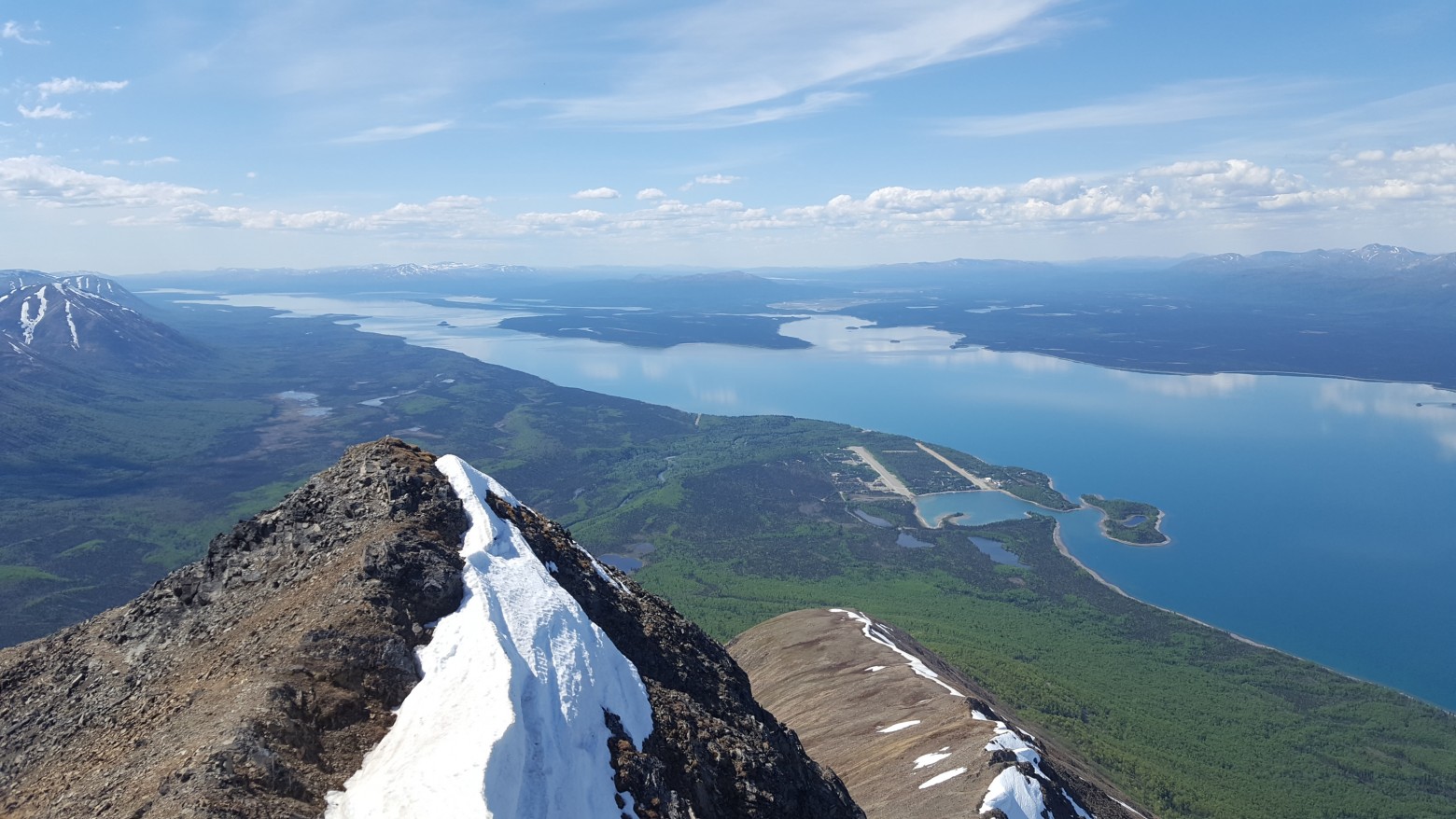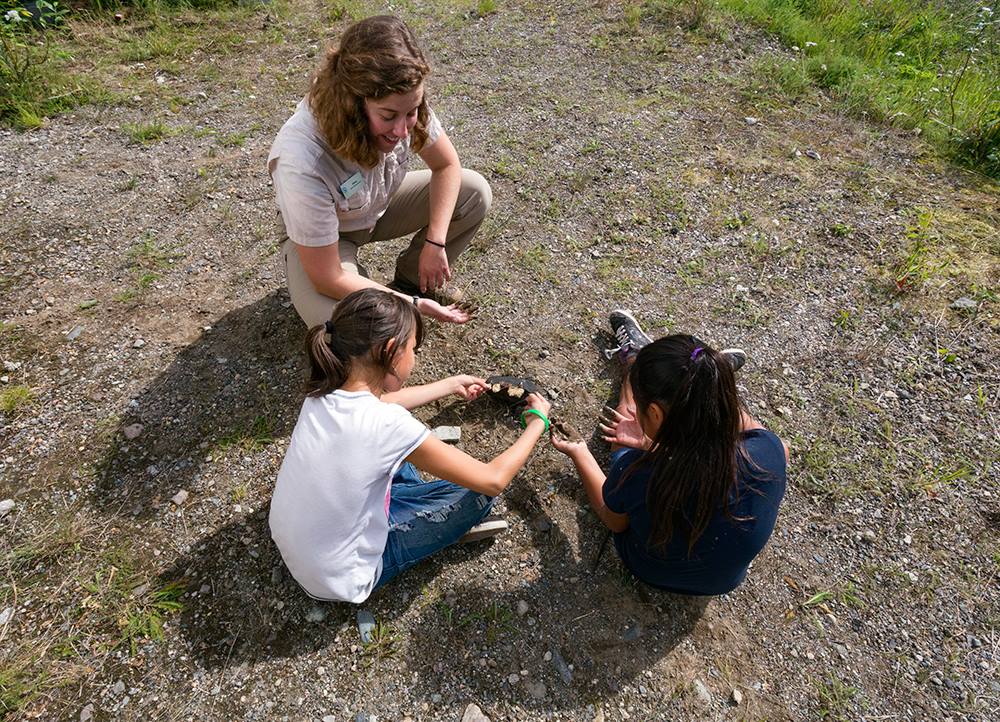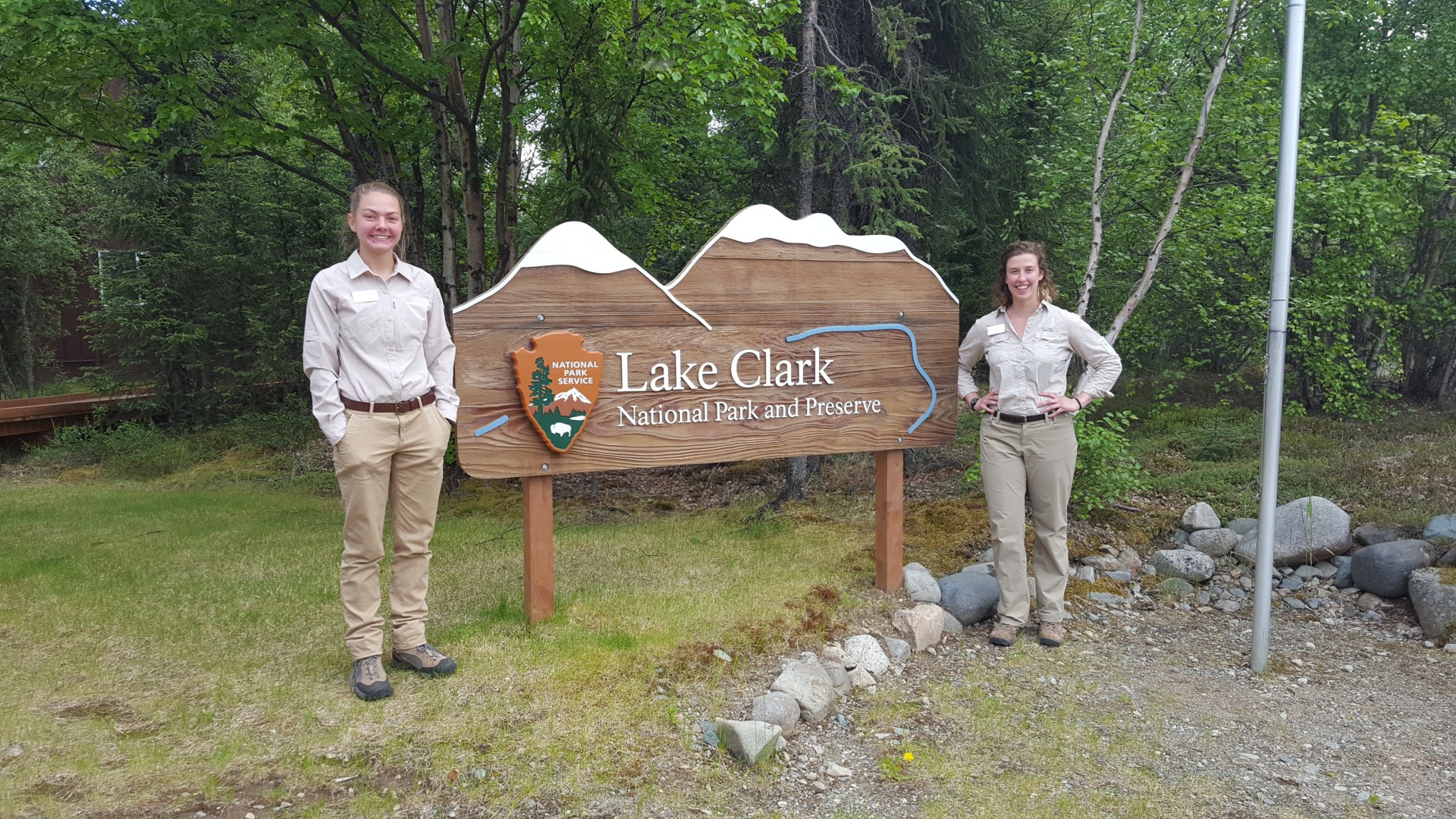
The view from the peak of Tanalian Mountain, which looks down on Port Alsworth. (Olivia Urbanski/Loyola University Chicago)

The view from the peak of Tanalian Mountain, which looks down on Port Alsworth. (Olivia Urbanski/Loyola University Chicago)
I climbed onto a 6-seater airplane that would take me to my destination for the summer – Port Alsworth – a tiny bush village in the middle of the Alaskan wilderness. I was set to work as a Visitor Services and Junior Ranger Intern at Lake Clark – a national park I had never heard of before applying to the position on the Student Conservation Association’s website (go check it out, there are countless environmental positions posted all the time for locations all over the U.S.!).
With all of my camping and hiking gear packed into a duffel bag and backpacking pack, I felt like I would be prepared for anything, though I actually had no idea what my summer would entail.
I also had four months of food in tow, since there are no grocery stores in Port Alsworth, and I couldn’t afford to fly back to Anchorage for grocery shopping. I quickly learned to love powdered eggs, powdered milk, powdered cheese, and even powdered butter. As different as it was living in a bush village, there is no doubt that I mentally adjusted to my surroundings much faster than my intestinal tract did.
Port Alsworth is a tiny community located on an inlet of the 40-mile long Lake Clark, completely surrounded by mountains. Centered around two gravel airplane runways, there are about 150 people who live in Port Alsworth year-round, growing to well over 200 in the summer. The town is located smack-dab in the middle of the United States’ 5th largest national park – Lake Clark National Park and Preserve – which is composed of more than 4 million acres of pristine Alaskan wilderness.

As I settled into my new position, I learned that Tuesday mornings were dedicated to the local children. Just before 10 a.m., kids stormed Lake Clark’s tiny visitor center, eagerly anticipating the week’s Junior Ranger Program. Rachel Hellwig (my internship had two positions, so Rachel was my other half for the summer) and I planned and ran the 12-week Junior Ranger program. Unlike most national parks where Junior Ranger programs are designed for visiting youth, the programs at Lake Clark are aimed more toward local residents because Lake Clark National Park draws a vastly different visiting audience than a park like Yellowstone, since it is so remote and rugged.
Usually it took the kids a few minutes to settle down before they could focus on the day’s activities; most of these kids have known one another their entire lives and are often related. Sometimes the Junior Ranger program felt like an entire community play date.
Each week’s program had a unique theme. One week we focused on salmon, which coincided with the beginning of the salmon run. “Can anyone tell me what type of fish this is?” I asked, pointing to a huge hand-drawn picture of what I hoped they’d be able to recognize as the iconic Alaskan fish. The kids were quickly able to identify my poorly drawn salmon, and soon they were coloring their own salmon shaped hats and playing the “pin the tail on the salmon” game, which Rachel and I had created to introduce the Junior Rangers to the day’s “Salmon Spawning” lesson. As usual, I was surprised by the vast amount of information the kids already knew about the natural world around them. Sometimes they even knew more than I did; many of them had lived in Port Alsworth their entire lives and were intimately connected with nature and wildlife surrounding the area. While I had been studying ecosystems and environmental policies for longer than some of them had been alive, I had just moved to the area at the beginning of the summer. I was constantly reminded of how many intricacies there are to learn about our amazing planet and the impact we have on the environment.
As a double major in environmental studies and international studies, I have great interest in international climate change negotiations. To my dismay, as the Paris Agreement took shape in 2015, I noticed little has been done that is actually working toward the agreement’s goal of keeping the planet’s temperature rise well below 2-degrees Celsius. While large-scale actions are important to understand, local communities like Port Alsworth have the ability to implement policies and practices that can more quickly contribute to the goals of global climate policies.
Additionally, environmental ethics plays a role global climate policies, specifically in getting individuals to do their part in caring for the planet. Experiences in nature are the key to cultivating a sense of environmental stewardship. If those experiences can happen at a young age, it will likely lead to lifelong stewardship actions that help take care of the environment. However, this theory employs a tricky balance – while experiences are essential, those experiences must not harm the environment, as that would contradict the process. It is essential to balance the relationship between humans and the environment in a healthy way, so we can have enriching experiences in nature without damaging the nature we are so keen on protecting from misuse.
This is the perplexing dichotomy of environmental ethics. In order for someone to value nature to the extent of wanting to protect it, a personal experience within the environment is necessary. However, a personal experience within nature (and the increase of many people experiencing natural surroundings) can degrade nature in potentially irreversible ways.
My own interest in the environment had been shaped by my time outdoors when I was younger. From overnight camps and hikes with my Girl Scout Troop, to family trips to Yellowstone and the earning of my own Junior Ranger badges, my understanding and perspective on the environment was heavily influenced by experiential learning at a young age. I decided it was necessary to take a step back from the large-scale policy spectrum and understand what was happening in the environment at a local level.
When I arrived in Port Alsworth, I was the outsider. I thought I was coming to impart my “vast” environmental knowledge to a community. Yet, it turns out that Port Alsworth residents actually knew more about the surrounding environment than I did. The residents knew the land like the back of their hand and are connected to it, and in some cases, have been for generations. As I became a member of the Port Alsworth community through my work with the National Park Service, I soon discovered that the community is integral to Lake Clark National Park’s complex history and conservation.
Lake Clark became a national park and preserve in 1980 through the passage of Alaska National Interest Lands Conservation Act (ANILCA). However, the land had been inhabited by the Dena’ina Athabascan people since the end of the last ice age. This meant that people had been relying on this land for thousands of years. Traditional subsistence practices such as hunting, fishing, and harvesting had been passed down through generations. Today, many Port Alsworth residents continue these practices within the national park, many honoring their native heritage by doing so.
While these practices may seem quite contradictory to traditional environmental preservationist beliefs, especially within a national park, subsistence use has been in place for hundreds of years, carefully taught and passed on to younger generations by the generations before them. These conflicting perspectives could cause a rift between the National Park Service (NPS) and Port Alsworth residents. However, the NPS staff, native residents, and community members have working relationships that express, understand, and work through differences between cultural practices and conservation measures in a pragmatic way. Today’s politics make it seem impossible, but environmental policies can be implemented to benefit both the land and the community.
This complex relationship exists within and around each U.S. national park, since each park has a unique heritage of local peoples. The Grand Canyon has 11 traditionally associated tribes who consider the Grand Canyon as their homeland; parks in the Dakotas caused tension between the U.S. government and native tribes; and Yosemite and Kings Canyon are in close proximity to large, developed cities, just as so many cities are expanding closer to natural areas. These communities are just one part of the essential factors that can greatly contribute to national parks’ conservation if treated respectfully and if a working relationship between the park service and community is maintained.

Now, the NPS has been in the news a fair bit over the past couple of years. From Obama signing to establish two new national monuments protecting 1.65 million acres during his last few months in office and the celebration of the NPS centennial in 2016, there have been some high notes for to the park service. However, NPS has also experienced significant lows such as the end of the six-year plastic water bottle ban, headlines announcing the possibility of increasing entrance fee, and the current administration’s reduction of protected land within the newest national monuments.
The NPS is in dire need of support and improved infrastructure, specifically needing support from the American public and financial resources from the government. To increase public awareness, the 2016 NPS campaign, “Find Your Park” was aimed at getting more Americans into national parks and to become aware of the land’s natural resources and cultural heritage. But the parks also face dwindling financial assistance — the 2018 budget for NPS is just about $300 million short of the 2017 budget. To mitigate such financial cuts, NPS has proposed significant admission increases to 17 of the nation’s most popular parks, including the Grand Canyon, Glacier, Yellowstone, Yosemite, Zion, and Arches.
While the NPS does need to find funding from somewhere other than the government since the proposed budget changes make it more difficult for Americans (especially those with lower income) to experience the solace of nature, this proposal goes full circle, and brings us back to the ethical dilemma of environmentalism, and the fine line NPS struggles to walk. While the park service wants more people to enter and experience parks, an increase in visitors can degrade land and natural resources quickly, going against the park service’s original goal to preserve and protect our national lands.
If we are able to teach values of protecting and respecting the environment to kids through personal experiences outdoors, we can create future generations of environmental stewards, that can have a positive impact on not only our public lands but our entire planet.
By the end my summer in Alaska, Rachel and I created and ran more than 12 Junior Ranger programs for the kids of Port Alsworth. Our Junior Rangers explored everything from Alaska’s forest ecology to the leafrollers found hanging from countless birch trees. I was lucky to help Port Alsworth’s youth delve deeper into understanding their surrounding environment and introducing them to environmental concepts through the silliest of games. This fosters a greater sense of intrinsic value through positive experiences in the great outdoors they are so lucky to call their backyard. These positive outdoor experiences taking place during the formative years of children’s lives now have the ability to shape the way they interact with nature for the rest of their lives.
While my summer internship was a once-in-a-lifetime opportunity to live in the Alaskan wilderness, work with phenomenal park rangers, and hone my environmental education knowledge, I eventually had to face reality and return to the concrete jungle. It can be easy to get lost in the shuffle of never-ending to-do lists and the fast pace of life, but taking a minute to not only recognize the importance of outdoor experiences, but honoring them will do great things for your health and mood (even in crazy cold January temps — just dress warmly enough). Take a quick walk outside on your lunch break. Challenge yourself to identify that tree you always pass on your way into work. Actually listen to bird calls and songs. Spend a family vacation exploring a national park. Take the youngsters in your life to environmental learning centers. Our environment is struggling to thrive in today’s economic and political climate, and it is up to us to do our part to develop a sense of environmental stewardship within ourselves and future generations.